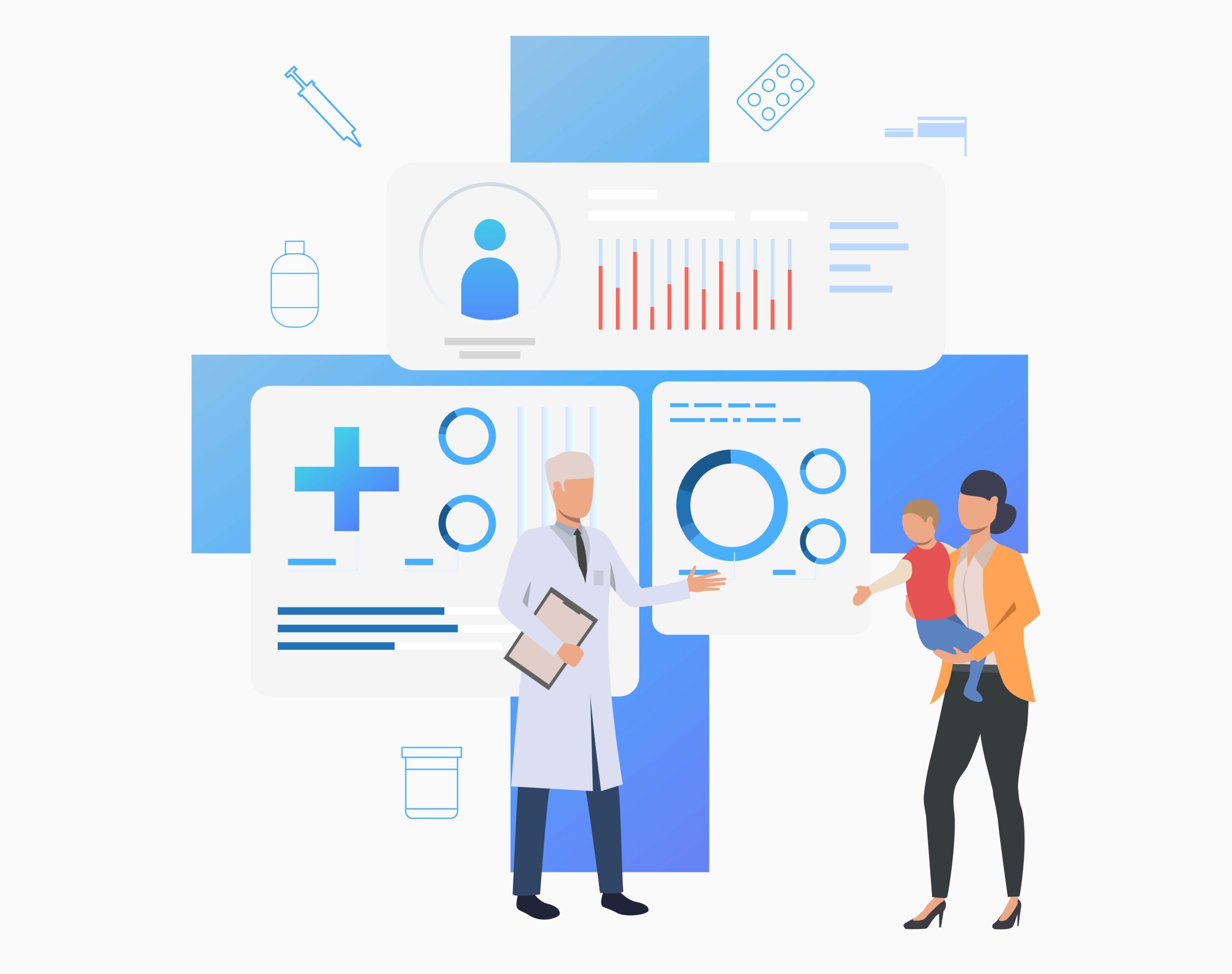UI/UX design services is revolutionizing the patient experience in healthcare.
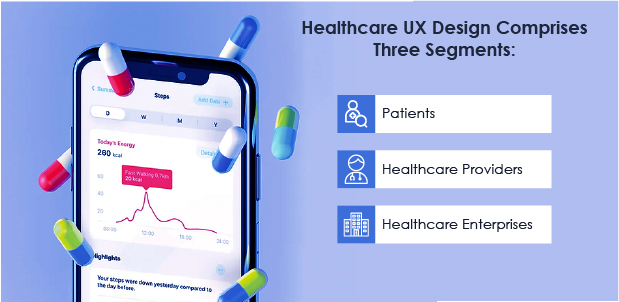
Healthcare UX design comprises three segments: patients, healthcare providers, and healthcare enterprises. Of the three, the significant value-add and the primary focus of healthcare UX design is on the patients, especially when considering UX design services in healthcare. Therefore, the designers need to be empathetic and ensure that they understand the users’ pain.
Healthcare mobile apps/websites are often used during emergencies or situations requiring immediate attention, highlighting the importance of UX design services in healthcare. In such cases, if the design is complex and confusing, it will only worsen the situation and waste the user’s time, which they might not have. Hence, with healthcare UX, a designer must keep the patients in mind and must invoke feelings of empathy to ensure that the design so created is helpful, easy to use, and accessible all at the same time.
Before we look at how Healthcare UX Design is changing the patient experience in healthcare for good, let us first understand what Healthcare UX Design means.
What is Healthcare UX?
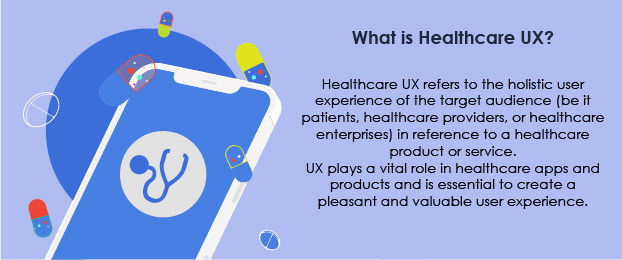
The Coming of Age of Healthcare UX
The field of healthcare and medical science has witnessed rapid advances over the last few years. With the advent of various healthcare applications and virtual clinics, the experience of doctors, healthcare providers, and patients has changed drastically.
With the challenges arising due to the pandemic, healthcare professionals and modern designers & engineers have been forced to come up with innovative solutions that can solve all health-related issues without compromising healthcare quality.
However, designing products and services in the digital environment is a challenging task. And this task becomes even more challenging when dealing with sensitive issues like healthcare. Often times the UI/UX designs fail to meet the target audience’s needs. This is where healthcare professionals and healthcare providers need to get in touch with professional UI/UX designers. These design professionals bring a user-centered approach to the process, which is extremely critical to healthcare.
Healthcare UX is an interdisciplinary concept where both design and healthcare join hands to create products and services that can meet users’ needs. To ensure a good overall experience, well-designed applications are a must.
Based on recent trends in digital healthcare, UI/UX designers need to focus on this development. Design professionals must ensure that the user interface design for healthcare applications adheres to the basic UI/UX principles.
Healthcare UX – Why is it Important?
With new technologies and solutions emerging in the field of medicine, healthcare UX is becoming increasingly important. The importance of UX in healthcare (just like any other discipline dealing with technological advancement) cannot be neglected.
Modern healthcare products must have usable, functional, and accessible designs to help patients and healthcare providers. With many digital services, including healthcare websites and mobile applications, it is essential to improve the value of medical user interface design. Hence, organizations creating healthcare technologies must focus on the usefulness and usability of their products and services. On the other hand, the designers need to consider the critical aspects of healthcare UX design and implement those in their projects. UX in digital healthcare has various benefits:

Examples of Healthcare UX
Good UX is critical to the success of any modern technology. The same goes for healthcare. Let’s look at some of the examples from the modern healthcare industry where UI/UX has played a crucial role in the success of MedTech.
1. Wearable Tech
Wearable tech is one of the up-and-coming trends nowadays. Smartwatches and Smart bands are embedded with various features that can help monitor an individual’s health. These technologies can also be used in emergencies to seek medical help. Fitbit and HeartGuide BP Monitor Watch are some of the prime examples of wearable technologies in the healthcare industry.

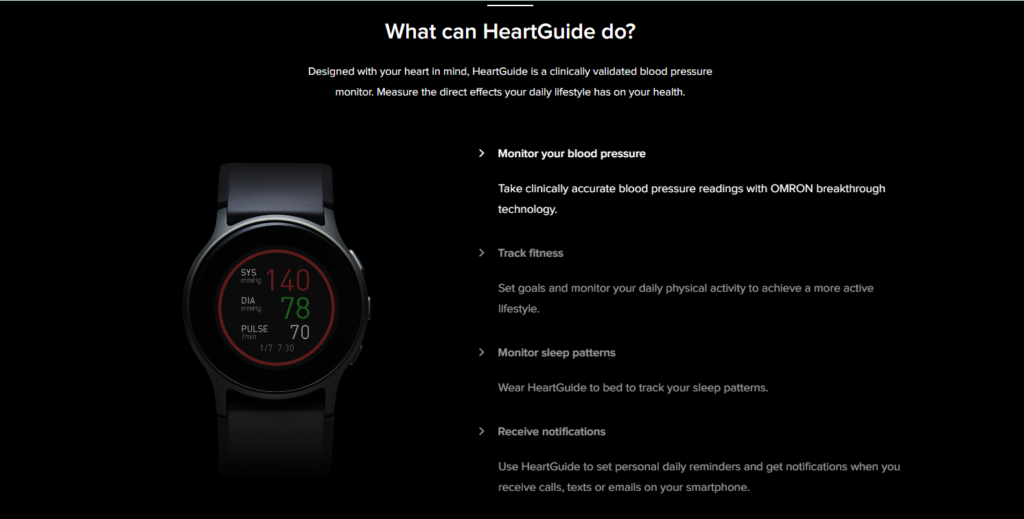
2. Telemedicine
Another rising trend in Healthcare is using online or virtual appointments with a healthcare professional. COVID-19 is partly responsible for this trend. This way of seeking consultation is often called telemedicine or virtual clinic. Several apps and websites are designed to schedule appointments and manage virtual communication between doctors and patients. One such popular telemedicine platform is MDLIVE.
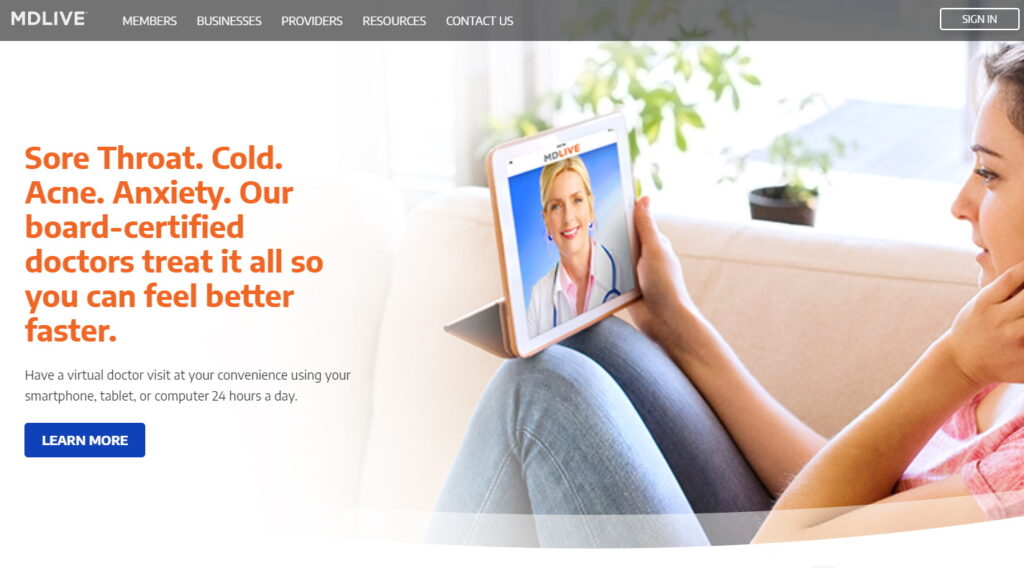
3. Chatbots
Over the years, Chatbots have often been the answer to managing fast and efficient communication. The use of chatbots in Healthcare has proven to be an excellent resource for healthcare providers and patients alike. In some cases, these chatbots can resolve a patient’s entire issue in a very short time. Babylon Health Chatbot is one such example. It promises to provide 24/7 healthcare assistance.
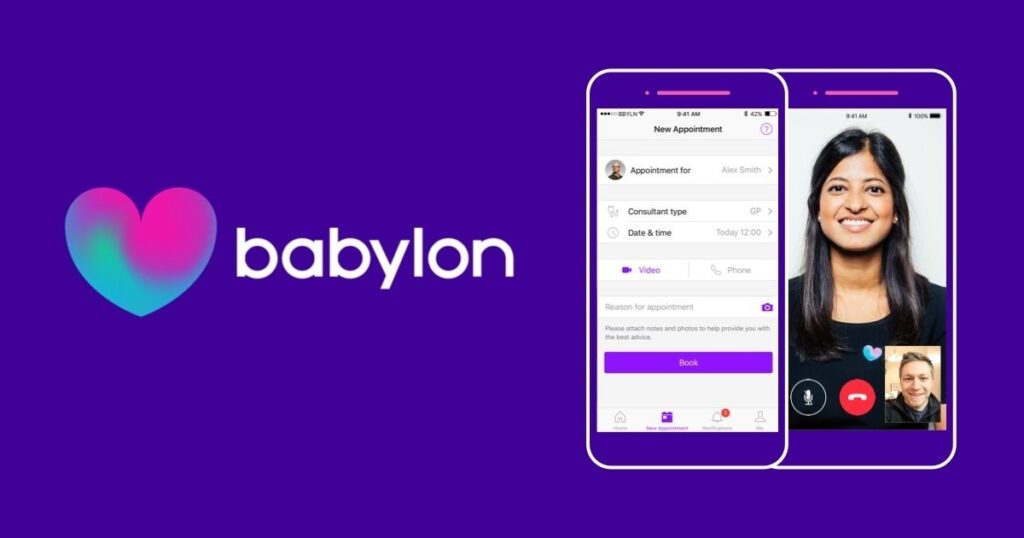
4. Virtual Assistants for Mental Health
Modern healthcare tech also focuses on mental health. In grueling times like the pandemic, people’s mental health has taken a very heavy toll. In times like this, people need someone to talk to, to share their problems, and seek guidance. With the introduction of virtual assistants (focusing primarily on mental health), there has been some considerable advancement in this area. One such example is Replika, which assists its users in chat and audio calls.
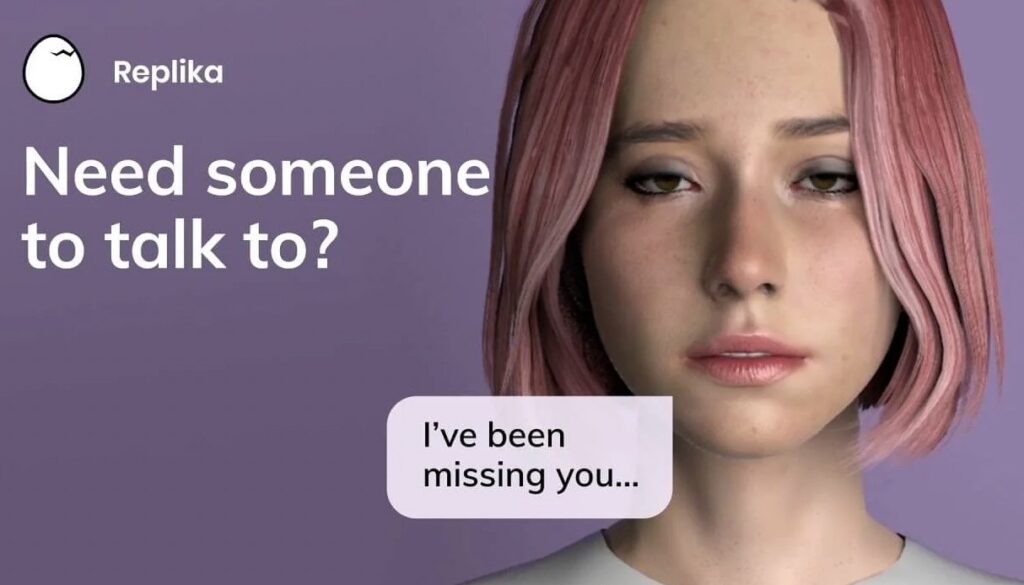
Concerns for Healthcare UX Designers

Some of the important things that designers should always keep in mind while designing a product or service for the healthcare industry are:
1. Ease of Use
Healthcare products and services are used most often during critical situations. For situations wherein the patient might be suffering from a serious disease, or a doctor is uploading medical records, the design needs to be simple and easy in order to make the task easier and aid the user rather than becoming an obstruction.
2. Privacy & Data Security
Details pertaining to a patient’s medical record are extremely sensitive. Hence, while dealing with digital healthcare tech, designers must ensure privacy and security of this data. The best way to achieve this, especially in healthcare, is by being transparent about the data being gathered and by giving control to the users.
3. Accessibility
Another important concern that designers should always keep in mind while designing a product or service for the healthcare industry is Accessibility. When dealing with healthcare tech, it is crucial to understand that some users might have some physical disabilities and might need special assistance. Therefore, the design must be embedded with features that aid the users during their interaction with these healthcare products and services. For instance, an in-built screen reader can help users with hearing disabilities.
4. Adaptability
Adaptability is another important concern for healthcare UX designers. They must ensure that the design is adaptable, expandable, and above all, flexible.
In other words, if a particular healthcare tech is to be used in another country or some other culture, it shouldn’t make the user’s life difficult. This is where the knowledge of cultural factors, (a.k.a cultural intelligence) comes into play.
UI/UX designers should create designs in a way that they are easy to update in the future. When new concerns arise, or the design needs to be altered, it should not require the team to work from scratch.
Along with all this, another key factor that must be kept in mind is to make sure that Healthcare compliance is adhered to in every possible way. In other words, you must ensure that your healthcare products and services abide by all legal, ethical & professional compliance standards in healthcare.
Interoperability is the Key!
Healthcare IT teams and vendors have long been interested in healthcare system interoperability as a major driver of technological innovation. But its importance goes beyond just improving technology – our modern, interconnected healthcare system means it is at the forefront in the battle of improving the overall patient experience.
What is Interoperability?
Every time a patient visits a doctor, they are asked to provide a lot of information like symptoms, diagnosis, drugs prescribed, along with their basic info like age, weight, height, blood type, any existing medical condition, etc. Filling out all this information every time one visits a doctor becomes an extremely tiring and cumbersome task. In some emergency cases, this can even cause more problems than one. Now, in a perfect world, all of this information would be accessible to every medical institution across the country that the patient may or may not have visited. But unfortunately, that is hardly the case. This is because of a lack of interoperability.

Interoperability refers to the ability of different information systems to communicate and share information. This is what’s lacking in healthcare information systems across the globe. This leads to patients having to fill out the same forms and answer the same questions with each new healthcare provider. This further increases the risk of information about existing health conditions & diagnoses not reaching the medical providers caring for a patient. This isn’t just frustrating for patients – it’s also dangerous. Imagine a patient arriving at an emergency room and the doctors there being unaware that they were recently diagnosed with a serious heart condition.
In other words, solving the interoperability conundrum has become central to the question of how healthcare providers and vendors can improve the patient experience.
Interoperability is already a prime concern in digital healthcare strategy, whether for patient concerns or for matters of technology cost and planning. The benefits of interoperability go beyond just being technologically advantageous.
Next-generation patient experiences will require seamless interoperability that links different providers, bridges the gap between consumer and clinical solutions, and finally takes digital health beyond outmoded patient portals.
How Can Worxwide Help You?
Just like all the other industries, healthcare and medicine are in dire need of professional UI/UX designers, for the impact created by good designs holds great value for healthcare providers, healthcare enterprises, and patients alike. Based on the current market trends and ever-growing demand for better UI/UX across healthcare, the demand for good UI and UX design is only going to increase.
Worxwide Consulting, a top management consulting firms that help companies drive digital growth by improving user and customer experience. We help companies with end-to-end product design or UX design services that include research, strategy, design, test product designs and prototypes. Worxwide based out of US, UK, and India offering bid consulting, sales transformation, user experience and customer experience design services.
To stay ahead of the rest of the competition, get in touch with our expert UI/UX designers at Worxwide Consulting and start your journey toward excellent Healthcare UX today.


tx, USA

London, UK

India


